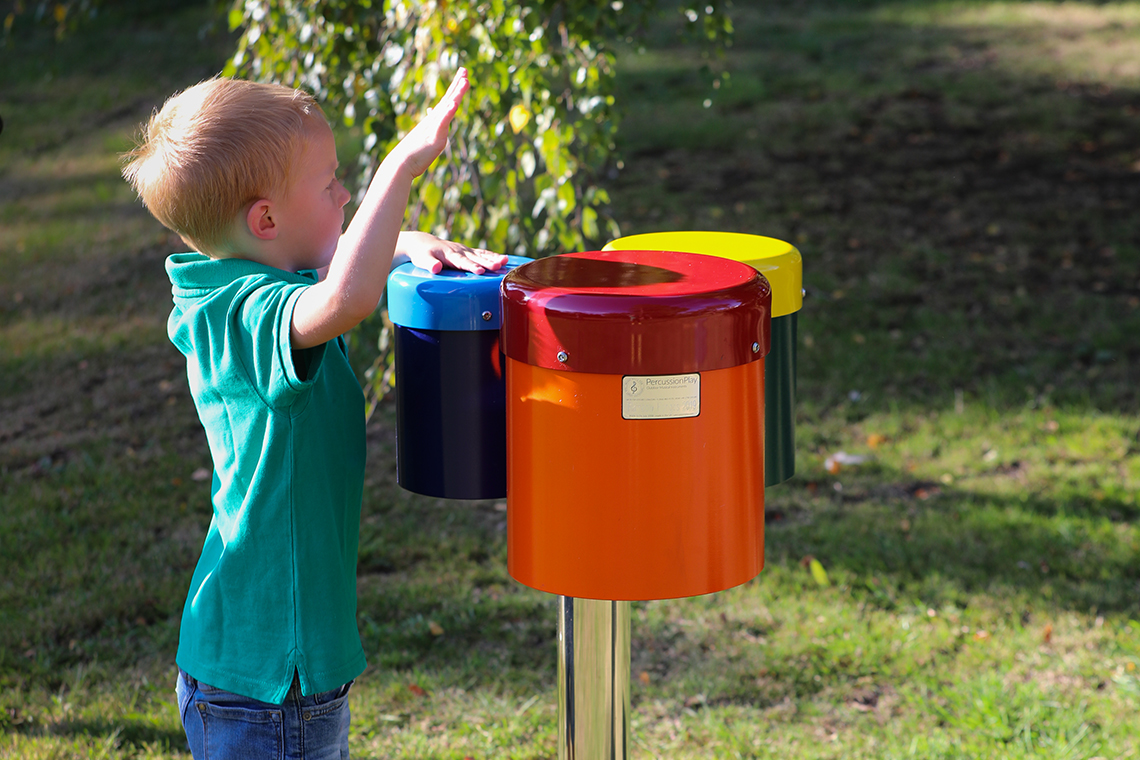In Ground and Surface Versions Now Available For Popular Rainbow Trio Ensemble
Originally designed to be hung on playground walls, we’ve extended our Rainbow Trio Ensemble to now include in-ground or surface-mounted versions of these three sweet little instruments.
Five reasons to love our ‘Mini’ Rainbow Trio Ensemble
- Size is everything
The small and compact size makes these instruments appealing for smaller organizations such as nursery schools, pre-schools and kindergartens. Occupying less space than the full-size instruments this bright, inviting range requires less budget too! Most tasks young children learn to do are much easier if they have objects that are made in a size that is right for their age. This range is the perfect size for little ones.
- Colour Matters
Children love fun, bright colours and find themselves drawn to colourful items that spark the imagination. As their eyes are not fully developed they perceive these colours better than fainter shades. Bright colours and contrasting colours stand out more in a child’s field of vision and as they constantly strive to make sense of their environments, bright objects are more stimulating and interesting to them. One of the first ways we learn to sort things is by colour, also colour names are some of the first words we learn. We quickly learn from a young age to associate colours with particular objects e.g. yellow with the sun, blue with the sky, green with grass, so it’s no real surprise that the brighter rainbow colours appeal to children.
Plus we've never met a rainbow we didn't like.
- The Power of Music
Pre-schoolers learn the most through play and hands-on activities, and using these small musical instruments they’ll have the opportunity to master a variety of skills while benefiting from the fresh air. Through playing the Rainbow range children are treated to a wonderful sensory experience. They’ll inspire creativity and build confidence as well as encourage sharing. However, the benefits also go a little deeper by:
- Creating an enabling environment with stimulating resources and play opportunities
- Encourage active learning, play and exploration, creativity and critical thinking
- Offer opportunities for practitioners to observe the prime and specific areas of learning
- Develop control using one hand, and encourages the use of a dominant hand
- Learn that music and sound can reflect feelings and ideas by exploring musical play
- Help children capture experiences creatively through music and dance
- Strengthen positive views children have of their own cultures
- The Fizziest Five Notes
It seems strange to miss a note, doesn’t it? Well, there is a good reason why we tune many of our instruments to the Pentatonic Scale, including those in the Rainbow Range. ‘Penta’ is Greek for ‘five’ and ‘tonic’ means ‘tone’. The Pentatonic Scale is a five-note scale Do, Re, Mi, So, La (note no Fa or Ti). These notes are not consecutive, and the half step is missed, putting a minor 3rd at the top of the scale. It makes a natural and instinctive sound and is easy to imitate. Composer Zoltan Kodály devised an approach to learning music which fully embraced the use of the pentatonic scale when teaching young children. He believed that the beginnings of music education should be made in the pentatonic scale because it is the wellspring of all music. Somewhat appropriately, the pentatonic scale carries with it an endearing, simple, lilting, carefree quality that characterizes childhood itself. Find out more about using the Pentatonic Scale for Early Years or read our White Paper Five Notes to Rule Them All: The Power of the Pentatonic Scale . (Note: Rainbow Trio Bongos are percussive and not tuned to the pentatonic scale)
- Easy Fix
The Rainbow Trio Ensemble is easy to securely fix in the ground, on the surface or to a wall, you can even bring the outdoors in by installing the instruments indoors. They simply require an easy single post-installation at just the right playable height. Very low maintenance, this range is perfect for busy playgrounds, shady yards, outdoor classrooms, and sensory gardens.




